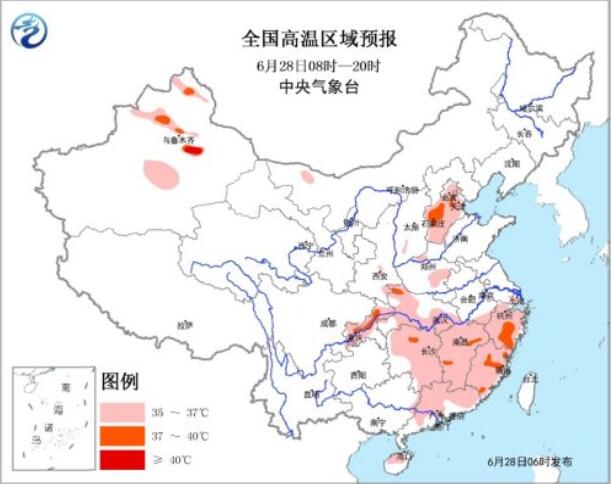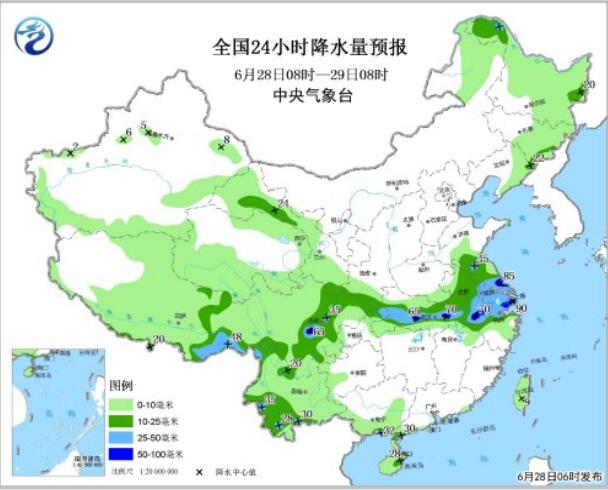CCTV News:In the past two days, the high-temperature "roasting" mode has been opened in central and southern North China and other places. The Central Meteorological Observatory predicts that in the next three days, high temperature of 35 ~ 37℃ will continue to occur in eastern North China, most of the south of the Yangtze River, and central and eastern South China, and the local maximum temperature can reach 38 ~ 40℃.

Welcome hot weather in many places
Since the 26th, the temperature in Beijing has been soaring and the sun is scorching, and people are shouting "it’s going to be sunburned" when they go out. Citizens are "armed to the teeth", and umbrellas, clothes, folding fans and other items have become "artifacts" for shading and heatstroke prevention.
Shanghai also has a "high fever". Yesterday, Shanghai issued a high-temperature orange warning. The heat wave is rolling, and the mobile spray system is turned on on the Bund. The cold fog from time to time allows citizens and tourists to enjoy a coolness under the scorching sun.
The highest temperature in most parts of Tianjin exceeds 37℃, and the combination of high temperature and exposure brings inconvenience to people’s travel. Last week, most parts of Tianjin received rain, and the air humidity was high. This week, the high temperature hit, causing the weather to become sultry. Many travelers wore umbrellas and sun hats, and some plants along the road were also listless. Some residents used wet wipes to cool the exposed bicycle seats.
On the 27th, the Hebei Meteorological Observatory released the first high-temperature red warning signal this year. The highest temperatures in Baoding, Langfang and most parts of the south reached 37℃ to 39℃, and the highest temperatures in some areas exceeded 40℃. The heat waves rolled on the urban roads, emitting layers of steam from a distance. In view of the high temperature weather, relevant departments in Langfang, Cheng ‘an and Fengfeng, Hebei, sent summer products to outdoor workers, and took active measures to ensure water supply in summer to cope with the continuous high temperature.
The temperature in Dongying, Shandong Province has also reached 36℃, and citizens who travel have put on sunscreen tools. According to the forecast of the meteorological department, the weather in Dongying, Shandong Province will be mainly cloudy and sunny in the next few days, and the highest temperature will remain above 32℃.
From June 24th to yesterday (27th), Jiangxi Meteorological Observatory has issued high-temperature yellow warning for four consecutive days, and the highest temperatures in many places in Jiangxi have reached above 37℃. In these two days, the highest temperature in Ganzhou reached 38℃, and the number of pedestrians on the road decreased significantly. The citizens who rode bicycles wore sun protection products. High temperature weather also makes air conditioners and electric fans sell well, and some residents go to appliance stores to buy them early in the morning.
On the 26th, Fujian Province also ushered in hot weather, with the highest temperature in 36 counties and cities exceeding 35℃, and the highest temperature in 7 counties and cities exceeding 37℃. At 4 o’clock in the afternoon on the 27th, the average temperature in Fuzhou, Fujian Province has exceeded 35℃, and pedestrians who go out cover themselves tightly. Many parks and outdoor leisure places have significantly fewer tourists than usual.
Jiangsu, Anhui, Henan and Hubei will face heavy rainfall.

While many places in China are suffering from high temperature, some areas in the middle and lower reaches of the Yangtze River are welcoming rainfall. The Central Meteorological Observatory predicts that in the next three days, there will be heavy rains and local heavy rains in parts of Jiangsu, Anhui, southern Henan, northern Hubei and central and eastern China, accompanied by strong convective weather such as short-term heavy precipitation or thunderstorms.
In addition, there are many showers or thunderstorms in Inner Mongolia and Northeast China; There will be moderate to heavy rain and local heavy rain in Sichuan Basin and Northwest China.